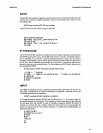
BASIC-SO
Commands and Statements
DELETE'
The DELETE command removes specified instruction lines from program
tex,t.
A
single line
or
block
of
lines may be deleted,
as
shown in the syntactic format and
example below. Instruction lines prior to and including the specified line may be
deleted by adding a dash
(-)
before a line number. When deleting a range
of
lines, the
line numbers specified as end points must exist.
If
not, an error results.
DELETE
line
numberlline
number-line
numberl-line
number
10 PRINT CHR$(12)
20
PRINT:PRINT:PRINT
30
REM THIS PROGRAM FINDS THE AVERAGE
40
REM
OFTHREE
NUMBERS
50
INPUT
A,B,C
60
PRINT
(A+
B+C)/3
70
END
DELETE-40
OK
LIST
50
INPUT
A,B,C
60
PRINT (A + B +
C)l3
70
END
OK
DELETE
70
OK
LIST
50
INPUT
A,B,C
60
PRINT
(A+
B+
C)/3
Ok
DIM
The DIM statement defines the number
of
elements in an array variable.
If
an
array
variable
is
not dimensioned before it
is
referenced, a default value
of
10
is
assumed
as
the maximum possible subscript range for each dimension in the reference.
If
given, DIM statements must allocate space before you refer to the arrays they
dimension, since once
an
array
is
dimensioned, these dimensions cannot be changed.
If
an
OPTION
BASE n statement
is
used in the program to specify starting points
for arrays, it should precede the first DIM statement, or array reference.
DIM variable
(integer
[,integer]
... ) [,variable
(integer
[,integer]
... ) ... ]
In the example below, A
is
a single precision array with
21
elements, indexed with a
value
of
from 0 to 20. I
is
an integer array with
13
times
14
(=
182)
elements.
S$
is
a
three dimensional string array with
125
elements. DD#
is
a singly dimensioned
double precision array with
22
elements.
10
DEFINT I-N
20
DIM A (20), 1(12,13),
S$
(4,4,4), DD#
(21)
6-5


















